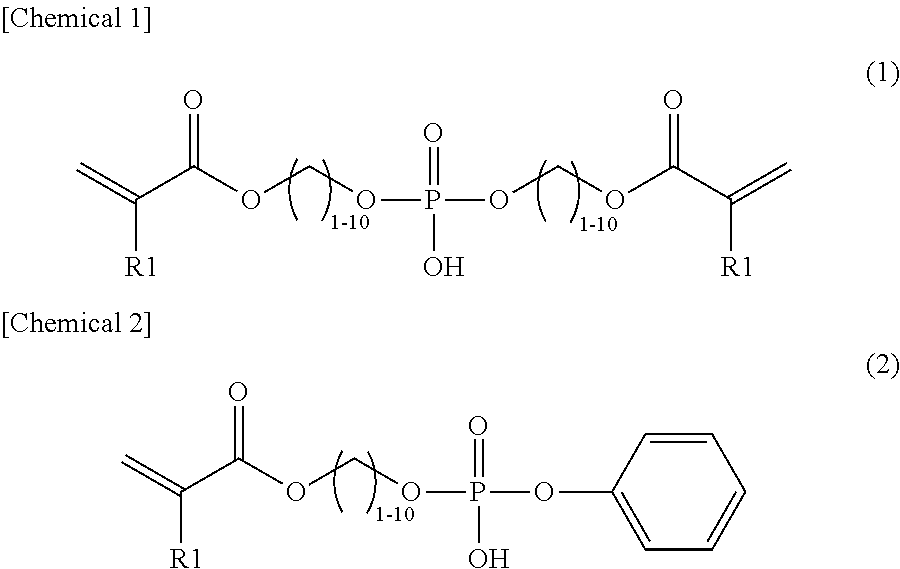Dental adhesive composition
a technology of adhesive composition and tooth, applied in the field of dental adhesive composition, can solve the problems of insufficient adhering force to the tooth, insufficient adhering strength, and insufficient adhering strength to withstand force, and achieve excellent adhering strength, high withstand, and improve the adhering strength to the tooth
- Summary
- Abstract
- Description
- Claims
- Application Information
AI Technical Summary
Benefits of technology
Problems solved by technology
Method used
Image
Examples
example 1
[0148]25.0 Grams of an equimolar mixture of PM1 and PM2, 30 g of BisGMA, 20 g of 3G and 25 g of HEMA as polymerizable monomers; 4.4 g of titanium isopropoxide as a source of titanium ions; 1.25 g of camphorquinone, 1.25 g of DMBE and 85 g of IPA as polymerization initiators; and 0.25 g of BHT, 0.19 g of HQME and 9.8 g of hydrophobic fumed silica having an average particle diameter of 0.01 μm as other components, were mixed and stirred together until it became homogeneous. Thereafter, 19 g of distilled water was added thereto, and the mixture was mixed and stirred again until it became homogeneous to thereby obtain a one-step type adhesive material comprising the dental adhesive composition of the invention for composite resin.
[0149]The adhesive material was measured for its phosphoric acid type polymerizable monomer, metal ions and pH. By using the adhesive material, an adhesion test piece was prepared according to the method of preparing the adhesion test piece I and was tested for...
examples 2 to 10
[0150]Adhesive materials of different compositions shown in Table 1 were prepared in accordance with the method of Example 1. The obtained one-step type adhesive materials for composite resin were measured for their phosphoric acid type polymerizable monomers, metal ions and pHs. By using these adhesive materials, adhesion test pieces were prepared according to the method of preparing the adhesion test piece I and were tested for their durability of adhesion to the enamel and to the dentin. The compositions of the adhesive materials were as shown in Table 1 and the results were as shown in Table 2.
examples 11 to 18
, Comparative Examples 17 to 31
[0158]Primers of the compositions shown in Tables 5 and 7 were prepared in the same manner as the adhesive material of Example 1, and were used for two-step type adhesive materials for composite resin.
[0159]The acid group-containing polymerizable monomers and various kinds of ions contained in the primers were measured. By using the primers, adhesion test pieces were prepared according to the method of preparing the adhesion test piece II and were tested for their adhering strength to the enamel and to the dentin after the durability test. The evaluated results were as shown in Tables 6 and 8.
[0160]
TABLE 5Primer (parts by mass)Note 1Polymerizable monomerPhosphoricdiesterCompounds ofEx.polymerizableOther polymerizableGroup IV elementOrganicNo.monomermonomersion sourcessolventWater11PM2 (12.1)PM1 (7.9), HEMA (80)Ti(O—i-Pr)4 (8.8)IPA (85)water (20)12PM2 (30.2)PM1 (19.8), HEMA (80)Ti(O—i-Pr)4 (13.6)IPA (85)water (20)13PM2 (30.2)PM1 (19.8), HEMA (50)Zr(O—i-...
PUM
| Property | Measurement | Unit |
|---|---|---|
| mole ratio | aaaaa | aaaaa |
| molar ratio | aaaaa | aaaaa |
| mole ratio | aaaaa | aaaaa |
Abstract
Description
Claims
Application Information
 Login to View More
Login to View More - R&D
- Intellectual Property
- Life Sciences
- Materials
- Tech Scout
- Unparalleled Data Quality
- Higher Quality Content
- 60% Fewer Hallucinations
Browse by: Latest US Patents, China's latest patents, Technical Efficacy Thesaurus, Application Domain, Technology Topic, Popular Technical Reports.
© 2025 PatSnap. All rights reserved.Legal|Privacy policy|Modern Slavery Act Transparency Statement|Sitemap|About US| Contact US: help@patsnap.com

